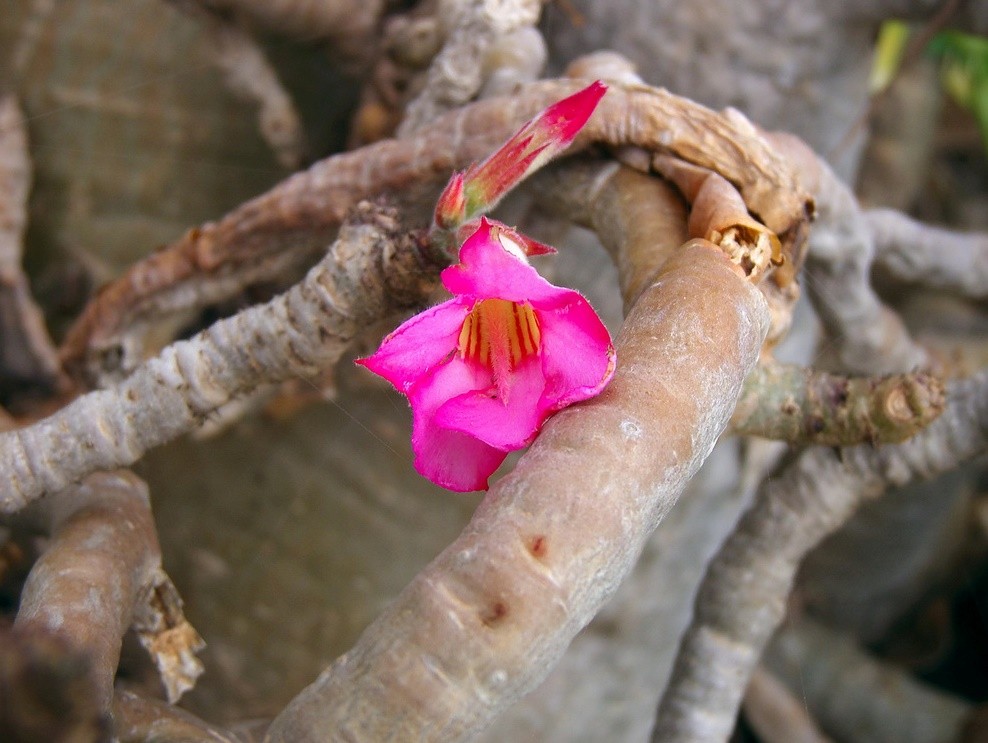Desert rose
(Adenium obesum obesum)

Description
Adenium obesum, commonly known as the Desert Rose, is a succulent plant species that belongs to the family Apocynaceae. This plant is native to Africa and the Arabian Peninsula, and it is known for its beautiful flowers and unique caudex formation. Adenium obesum is a popular ornamental plant in tropical and subtropical regions, and it is also used in traditional medicine for its medicinal properties. Description Adenium obesum is a small tree or shrub that can reach a height of up to 3 meters. It has a thick, swollen stem, known as the caudex, which stores water and nutrients during drought periods. The caudex can vary in size and shape depending on the age of the plant, and it can be smooth or covered in rough, wrinkled bark. The leaves of Adenium obesum are glossy, dark green, and oblong-shaped. They can grow up to 15 cm in length and 5 cm in width. The plant produces beautiful, trumpet-shaped flowers that can range in color from white to pink, red, and even purple. The flowers can be single or double and have a distinctive fragrance. Habitat and Distribution Adenium obesum is native to the semi-arid regions of sub-Saharan Africa, the Arabian Peninsula, and the island of Socotra in the Indian Ocean. It is commonly found in rocky or sandy soils in dry riverbeds, savannas, and scrublands. The plant is adapted to hot, dry climates, and it can tolerate temperatures up to 50°C. Cultivation Adenium obesum is a popular ornamental plant in tropical and subtropical regions. It is often grown in containers and used as a decorative plant on balconies, patios, and indoors. The plant prefers well-draining soil, and it should be watered sparingly, especially during the dormant period. Overwatering can cause root rot, which can be fatal to the plant. Adenium obesum requires full sun exposure to thrive, and it can be grown from seed or cuttings. The plant can be propagated by grafting, air-layering, or root cuttings. Adenium obesum is a slow-growing plant, and it can take several years to reach its full size. Medicinal Uses Adenium obesum has been used in traditional medicine for centuries. The plant is known for its antibacterial, antifungal, and anti-inflammatory properties. The sap of the plant is used to treat skin infections, burns, and wounds. The plant is also used to treat fever, malaria, and gastrointestinal disorders. However, it is important to note that Adenium obesum can be toxic if ingested. The plant contains cardiac glycosides, which can cause vomiting, diarrhea, and even death in humans and animals. Therefore, it should be used with caution and under the guidance of a qualified healthcare practitioner. Conclusion Adenium obesum, also known as the Desert Rose, is a beautiful and unique plant species that is prized for its ornamental value and medicinal properties. This succulent plant is native to Africa and the Arabian Peninsula, and it is adapted to hot, dry climates. Adenium obesum requires well-draining soil, full sun exposure, and sparing watering. It is a slow-growing plant that can take several years to reach its full size. While Adenium obesum has been used in traditional medicine for centuries, it should be used with caution due to its toxic properties.
Taxonomic tree:







